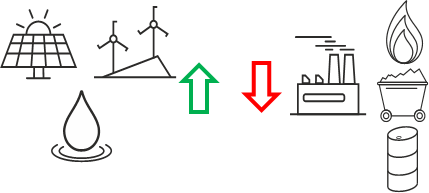Frequency stability in future grids
The grid structures and the operation of electricity grids are subject to unprecedented changes due to the rapidly advancing development of renewable energies.

Renewable generation such as wind and photovoltaic are connected to the grid via converters. Synchronous machines, which have many positive characteristics for grid operation and benefit from many decades of experience, are thus gradually being driven off the grid. In addition, the increased supply of renewable energy leads to a reduction of the inertia connected to the grid, so that disturbances will have a more serious effect on the stability of the grid.

Analysis of the dynamic stability in the context of the Austrian transmission system and reduced system inertia
A transmission system is described as dynamically stable if the synchronism is maintained during a sudden transition from one state to another (switching operations, errors in the transmission network). The resulting system response involves a strong oscillation of the generator pole wheel angles and depends on the initial state of the system and the strength of the disturbance. Due to the complexity of the system, it is necessary to carry out detailed dynamic simulations in order to obtain information about the stability. These simulations examine how long it may take until a fault (e.g. short circuit) must be cleared so that no generator loses synchronism.
Higher Rates of Change of Frequency (RoCoF)
Due to the reduced system inertia, the response of the grid frequency changes when loads and generators are connected or disconnected and in the event of major disturbances where an imbalance between generation and load occurs. In the first moment of a load change, the missing or excess power is compensated by the inertia connected to the grid. The energy emitted or absorbed by the rotating masses causes them to decelerate or accelerate, resulting in a corresponding drop or increase in the grid frequency. The rate of change of the grid frequency depends on the severity of the event and on the available inertia. Since inverter-driven generators do not provide inertia, the rate of change of frequency will be stronger in the future.
Measures to increase system stability
However, inverter-based generators have the advantage that their grid behaviour can be adapted by the programming of the inverter. Thus, a suitable response of these generators to changing system parameters, such as frequency, can be generated autonomously. Generators that have additional storage, or large battery storage systems, can thus contribute to grid stability.

This behaviour is called Fast Frequency Response (FFR) and can be divided into a fast acting Contigency FFR, and an Emergency FFR reserved for emergencies. FFR can react faster than the conventional primary frequency control, but is intended to support rather than replace it. Due to the high speed, a good detection system for the activation is essential to avoid false activations. In addition, too fast activation can slow down or even obstruct the primary frequency control.
Current research topics
- Examination of the dynamic stability of generators in networks with reduced inertia
- Development of control concepts for C-FFR and E-FFR and virtual inertia
- Interaction of C/E-FFR with classical primary frequency control and emergency measures in case of major grid disturbances
- Investigation of the advantages and disadvantages of different activation methods
- Comparison of the provision of C/E-FFR by large-scale storage facilities or by decentralized inverter-based generators equipped with small storage facilities
Finished Thesis
Alexander Rainer, Dissertation, Frequency Stability and Ancillary Services in Future Grids: The Role of Non-Synchronous Generation and Storage Systems (in progress)
Matthias Ennsberger, Dynamic Stability Study in the Austrian Transmission Grid (2019)
| Contact |
| Facts
|
| Partners
|

